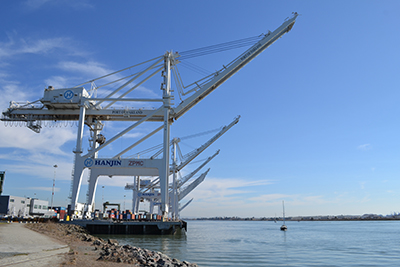June POLA and POLB volumes impress to varying degrees

While the annual percentage differences headed in different directions, June volumes at the Port of Los Angeles (POLA) and the Port of Long Beach (POLB) turned in solid performances, according to data issued by the ports this week.
Total POLA volume––at 764,777 TEU (Twenty-Foot Equivalent Units)––headed up 5.76% compared to June 2018, marking the highest-volume June in the 112 years of POLA operations. For fiscal year 2018-2019, total POLA volume rose 5.65% to 9,688,252 TEU.
June POLA imports––at 396,307 TEU––were up 3.48%, and exports––at 139,318 TEU––slipped 5.59%. Empty containers––at 229,153 TEU––headed up 18.97%. On a year-to-date basis through June, total POLA volume is up 5.33% to 4,538,635 TEU compared to the first six months of 2018, with full-year 2018 volumes representing the best volume year ever at the port.
“Completing the busiest 12-month period in the Port’s history makes me proud of our extraordinary capabilities and grateful to all our stakeholders,” said Port of Los Angeles Executive Director Gene Seroka in a statement. “With container exchange per vessel at record levels, we will continue to enhance and optimize our port complex in the coming months. Creating a universal truck reservation system, moving chassis off terminals and further refining the Port Optimizer are top priorities.”
Total June POLB volume––at 677,167 TEU––was down 10% annually compared to June 2018, which represented the busiest month in the 108-year history of the port.
June imports fell 13.7% to 331,617 TEU, and exports were flat at 138,833 TEU. Empties were off 9.1% to 211,718 TEU. POLB said that total volume through June––at 3.7 million TEU––was down 6.7%, while the second quarter was down 8.7% to 1.9 million TEU.
“The story we saw develop in 2018 was retailers forwarding goods to beat tariffs,” said POLB Executive Director Mario Cordero. “For 2019, it seems that the cargo is all here and warehouses are filled. That’s disrupting container movement and the growth we would normally see this time of year.”
Concerns over both the threat, and actual implementation, of tariffs has been front and center in the ocean shipping sector going back to March 2017. And those concerns are validated, given how United States retail container port import levels are expected to remain at high levels this summer, with only modest growth expected, according to the most recent edition of the Port Tracker Report, which was issued this week by the National Retail Federation and Hackett Associates.
Hackett Associates Founder Ben Hackett summed up the current situation, in the report, saying: “We can see that trade and imports are declining compared with last year’s growth rates as a result of the trade wars being waged by the United States in the global economy. Trade has become the sharp end of foreign policy, and we continue to believe that this will ultimately damage both sides of the conflict in a lose-lose situation. Imports of consumer goods continue to grow as importers purchase items in expectation of further increases in tariffs, the cost of which will be borne by the American consumer. This is beginning to have an impact on consumer sentiment, which is weakening.”
Beacon Economics’ International Trade Advisor Jock O’Connell said that the tariff pull-forward, which has led to higher inventories remains a major supply chain concern.
“I keep wondering where all the peak-period imports will go, given the stories I continue to hear of companies still storing goods they brought in late last year under tarps out in the employee parking lot,” he said. “There appears to be a huge amount of unsold inventory in the supply chains. It bears repeating that people should not assume that all imported goods go directly into the consumer market. Importers of machine parts or intermediate goods or institutional cleaning supplies who stocked up in the last quarter of 2018 may not be big importers this summer and fall.”

Article Topics
3PL News & Resources
Shipment and expenditure decreases trend down, notes Cass Freight Index March trucking tonnage trends down, reports ATA FTR Shippers Conditions Index enters negative territory DAT March Truckload Volume Index sees modest March gains National diesel average, for week of April 22, is down for the second straight week UPS reports first quarter earnings decline LM Podcast Series: Assessing the freight transportation and logistics markets with Tom Nightingale, AFS Logistics More 3PLLatest in Logistics
Shipment and expenditure decreases trend down, notes Cass Freight Index March trucking tonnage trends down, reports ATA FTR Shippers Conditions Index enters negative territory DAT March Truckload Volume Index sees modest March gains National diesel average, for week of April 22, is down for the second straight week UPS reports first quarter earnings decline LM Podcast Series: Assessing the freight transportation and logistics markets with Tom Nightingale, AFS Logistics More LogisticsAbout the Author
Subscribe to Logistics Management Magazine

Find out what the world's most innovative companies are doing to improve productivity in their plants and distribution centers.
Start your FREE subscription today.
April 2023 Logistics Management

Latest Resources














